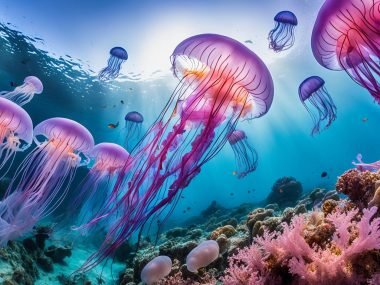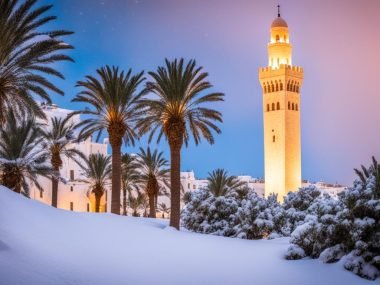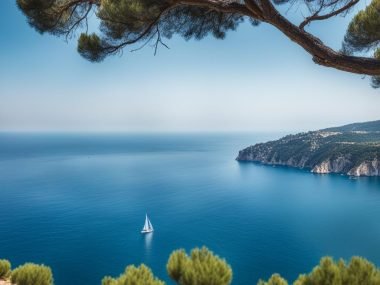Did you know Tunisia has over 1,300 kilometres of beautiful Mediterranean coastline? It’s true, even though it has many deserts. This amazing fact shows the variety of water landscapes in Tunisia. These include big coastal seas, calm lakes, and winding rivers. The water in Tunisia is very important for nature and keeps everything balanced.
You can find info on these water places on sites like Wikimedia Commons. They talk about Tunisia’s gulfs, lakes, rivers, and springs. The Strait of Sicily is very important. It shows Tunisia’s key location and its long history with the sea.
Key Takeaways
- Tunisia features over 1,300 kilometres of Mediterranean coastline.
- Diverse aquatic landscapes enrich Tunisia’s geography.
- Wikimedia Commons categorises Tunisian water bodies into gulfs, lakes, rivers, and springs.
- The Strait of Sicily is a crucial water body associated with Tunisia.
- Tunisia’s water bodies play a vital role in its ecological balance.
Introduction to Tunisian Water Bodies
Tunisia is known for its beautiful water bodies. These include the Mediterranean coast and inland waters. They are key to the country’s nature and people’s lives.
From the huge Mediterranean Sea to small Tunisian lakes and rivers, every water source is important. They all connect and support life.
The Importance of Water in Tunisia’s Geography
Tunisia’s lands are diverse because of its water. Tunisian rivers like Medjerda help farms grow crops. The sea is home to many sea creatures.
Having water sources in Tunisia means food grows and communities thrive. It shows how nature and people live together.
Overview of Major Water Sources
Tunisia has many important water sources. For example, big Tunisian lakes like Chott El Jerid change with the seasons. There are also many rivers and springs.
These water sources in Tunisia are vital. They help with farming, support animals, and keep nature balanced.
The Mediterranean Coastline
The Mediterranean Coastline is very important to Tunisia. It helps with the country’s water and weather. It also supports many different plants and animals.
Significance of the Mediterranean Sea
The Mediterranean Sea is crucial for Tunisia. It affects the weather and supports life. Its shores offer goods like fish and bring in tourists.
The connection between Tunisia’s rivers and its sea shores is complex. It helps keep the environment balanced. This balance is key for people and nature to thrive.
Coastal Ecosystems and Biodiversity
The shores of Tunisia are full of life. They provide homes for many sea creatures. Protecting these areas is very important.
We must use these areas carefully to keep them healthy. This helps many species live well together. Managing these shores well is crucial for Tunisia’s water and nature.
Saving these areas helps Tunisia’s rivers stay healthy. It also makes the country stronger against climate change. Keeping the sea and the land healthy together is essential.
| Aspect | Details |
|---|---|
| Climate Influence | Regulates temperatures, provides humidity, influences weather patterns. |
| Resources | Fishing grounds, tourism opportunities, coastal agriculture. |
| Biodiversity | Marine species, coastal habitats, protection efforts. |
| Conservation | Integrated strategies, sustainable utilisation, climate resilience. |
Chott El Jerid: The Largest Salt Lake
Chott El Jerid is the biggest salt lake in Tunisia. It’s a stunning place created by old volcanoes and human effort. These have changed its look over many years.

Formation and Geographical Features
This lake came to be from the earth’s natural work and people’s actions. It’s one of Tunisia’s key salt lakes, born from volcanic stuff. With time, cutting it from the sea turned it into a big salt flat.
Seasonal Changes and Economic Importance
Chott El Jerid changes with the seasons. A salt crust appears in the dry times. The wet times bring pools that look amazing. The lake is very important for jobs in the area. Getting salt from it helps the local people make money. Visitors come to see its beauty, which is great for tourism.
| Aspect | Details |
|---|---|
| Formation | Volcanic activity and interventions |
| Seasonal Changes | Dry season – salt crust; Wet season – water bodies |
| Economic Importance | Salt extraction and tourism |
Lakes of Tunisia
Tunisia has many beautiful lakes. They show the country’s natural beauty and ecological range. The Tunisian salt lakes, like Chott el Fedjedj and Chott el Gharsa, are very special. They attract many people with their unique features.
Notable Lakes: Chott el Fedjedj, Chott el Gharsa
Chott el Fedjedj and Chott el Gharsa are important Tunisian lakes. They are big salt lakes, known as “chotts.” Located in central Tunisia, they are key to the landscape.
Many species live in these lakes, adapting to the salty water. The lakes look amazing, especially as water and salt levels change over the year.
Eco-Tourism and Environmental Conservation
Eco-tourism is growing in Tunisia, with these lakes as main attractions. Visitors enjoy bird watching, hiking, and taking photos. It’s important to keep eco-tourism and nature protection in balance.
Protecting these lakes from pollution and harm is vital. Sustainable tourism can help save these special places for the future.
- Chott el Fedjedj: Noted for its expansive salt flats and unique wetland environment.
- Chott el Gharsa: Famous for its stunning desert backdrop and seasonal transformations.
| Lake | Key Features | Eco-Tourism Activities |
|---|---|---|
| Chott el Fedjedj | Expansive salt flats, unique wetland environment | Bird watching, hiking, photography |
| Chott el Gharsa | Desert backdrop, seasonal transformations | Eco-tours, sightseeing, wildlife observation |
Exploring Tunisia’s Rivers
Tunisia’s rivers are vital for its nature and economy. They help keep life going and support farms and factories.
Main Rivers: Medjerda, Miliane, and Other Watercourses
The Medjerda River is the longest in Tunisia. It is very important for farming. It starts in Algeria and goes through Tunisia’s fertile lands. This gives water to the crops.
Other important rivers include the Miliane and the Ichkeul. They help meet the water needs for farms and cities.
Role of Rivers in Agriculture and Industry
Rivers greatly help Tunisia’s farms and industries. The Medjerda River, for example, makes it possible to water crops like wheat, barley, and olives. These rivers also supply water for making things and creating power.
This shows how important rivers are for Tunisia’s money and growth. By looking after these rivers, Tunisia can grow while keeping its nature safe.
Springs and Oases of Tunisia
Tunisia is full of springs and oases. They are vital in the desert. These spots are not just beautiful. They are key for life in dry areas. The hot springs are famous for making people feel better.

Hydrothermal Springs
Tunisia’s springs are known for their special ground features and health perks. They have different temperatures and minerals. This makes them a favorite spot for those looking for health and relaxation. These springs are important. They provide water in the desert for people and nature.
Oases as Lifelines in the Desert
Oases in Tunisia are like islands of green in dry lands. They are crucial for farming and are places where communities gather. They help grow dates, pomegranates, and more. This is very important for the local people and the economy. These water sources in the desert are essential. They offer a pause from the tough desert weather.
Historic Waterways and Canals
Tunisia’s waterways and canals show ancient smartness in managing water. They reveal past people’s engineering skills. And their wise use of water.
Ancient Irrigation Systems
Long ago, creating complex irrigation was key for farming in Tunisia’s dry weather. Systems like the Barada River and big aqueducts show clever past water use. They helped support life back then.
Modern Use and Conservation Efforts
Now, those ancient irrigation works guide today’s efforts to save water. Modern skills mix with old methods to keep and make better use of water. Keeping these old waterways safe helps us now and in the future.
To show how old know-how and new tech work together, look at this table. It compares water management changes in Tunisia:
| Ancient Techniques | Modern Techniques |
|---|---|
| Extensive use of aqueducts | Advanced pipelines and infrastructure |
| Manual water distribution | Automated irrigation systems |
| Basic water storage | High-capacity reservoirs and dams |
| Dependence on natural water cycles | Integration with desalination and wastewater treatment |
By mixing old wisdom with new tech, Tunisia leads in smart water use. These steps to keep ancient and new methods show our promise to save water wisely. Together, we can keep water safe for everyone later on.
The Role of Dams and Reservoirs
In Tunisia, dams and reservoirs help manage our water. The Sidi Salem Dam, Mellegue Dam, and El Aroussia Dam are very important. They help us deal with water problems.
Major Dams: Sidi Salem, Mellegue, and El Aroussia
The Sidi Salem Dam is the biggest in Tunisia. It controls floods, helps with farming, and keeps water supply steady. The Mellegue and El Aroussia Dams support farms and industries too.
Impact on Water Resource Management
These dams are key for Tunisia’s water management. They make sure water gets to where it’s needed, efficiently. They help during droughts and floods, and improve life in their areas. Tunisian dam management focuses on being green and making the most of our water.
Groundwater Resources in Tunisia
In Tunisia, groundwater is very important for water supply. It helps with farming and household use. It is vital to manage these resources well for long-term use.
Importance of Aquifers
Aquifers are key for water balance in Tunisia. They supply water for farms and cities. It’s crucial for supporting agriculture and daily water needs.
Challenges of Over-Exploitation
Tunisian aquifers face big challenges from overuse. Too much water is taken out, which lowers water levels and quality. We must regulate water use to keep aquifers healthy.
| Resource | Current State | Concerns |
|---|---|---|
| Groundwater Resources | Over-exploited | Depletion and contamination |
| Tunisian Aquifers | Vital yet strained | Sustainable management needed |
| Water Supply for Agriculture | Heavily dependent on groundwater | Irrigation inefficiencies |
We need to tackle overuse of water resources. By monitoring and regulating use, we can save our aquifers for the future.
Environmental Challenges Facing Tunisian Water Bodies
Tunisia is facing tough environmental problems with its water. Climate change is making water scarce and dirty. It’s key to have good plans for saving water.
Climate Change and Water Scarcity
Weather changes a lot in Tunisia because of climate change. This makes it hard to get water. Lack of rain and too much dryness harm farming and our need for water daily. So, we need to change how we use water to keep it for the future.
Pollution and Conservation Strategies
Pollution is another big problem in Tunisia. It comes from farms and factories making water dirty. This bad water is not good for people or water animals. Good water saving plans are essential. We need better farming ways, strict rules on waste, and to clean water better.
We will look at these problems and how to fix them:
| Challenge | Impact | Strategies |
|---|---|---|
| Climate Change | Water Scarcity | Rainwater Harvesting, Efficient Irrigation Systems |
| Pollution | Contaminated Water Sources | Stringent Waste Management, Eco-friendly Practices |
| Over-extraction | Aquifer Depletion | Regulated Water Usage Policies |
We need many ways to solve Tunisia’s environmental issues. Innovative ideas and everyone’s help are crucial. By encouraging eco-friendly habits and spreading the word, we can protect Tunisia’s water for everyone.
Conclusion
Tunisia’s water geography is like a beautiful tapestry. It has the Mediterranean coastline, salty lakes, rivers, and hidden springs. Each one is very important for nature, the economy, and society. They help the country to grow and stay stable.
It is very important to manage water well in Tunisia. This is because the climate is changing and water is used a lot. We need to protect Tunisia’s water. We must find ways to meet people’s needs and look after nature. Using new technology and old knowledge can keep water safe for everyone in the future.
We must work together to look after Tunisia’s waters. Help from other countries and shared knowledge can help a lot. It’s our job to make sure Tunisia’s waters stay healthy. They are key to nature and to people’s lives and jobs.







